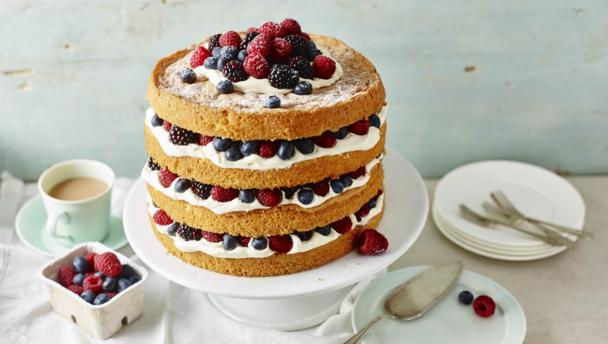Summer party gâteau

Ingredients
For the Genoese sponges
- 8 eggs
- 250g/9oz caster sugar
- 250g/9oz self-raising flour
- 100g/3½oz butter, melted and cooled, plus extra for greasing
To decorate
- 900ml/1½ pints double cream
- 400g/14oz raspberries
- 300g/10½oz blueberries
- 300g/10½oz blackberries
- icing sugar, for dusting
Method
-
This recipe is best started the day before you want to serve it. You will need two 23cm/9in round cake tins with 5cm/2in sides. Preheat the oven to 180C/160C Fan/Gas 4, then grease the tins with butter and line the bases with baking paper.
-
To make the sponges, put four of the eggs and half the caster sugar in a bowl and, using an electric hand whisk or food mixer, whisk until thick, pale and fluffy. When you lift the whisk, the batter dropping from it should leave a trail in the mixture below.
-
Sift half the flour into the mixture, and gently fold in to combine. Drizzle half the cooled melted butter around the outside of the mixture and carefully fold in before pouring into one of the prepared cake tins.
-
To make the second sponge, simply repeat steps two and three, and pour into the second tin.
-
Bake both sponges at the same time in the oven for about 30 minutes, or until pale golden-brown, firm in the middle and shrinking away from the sides of the tin. If not baking on the same shelf, you may need to swap the tins around halfway through to ensure you get an even bake.
-
Remove from the oven and, after 10 minutes, release from the tins and set aside to cool completely on a wire rack. Remove the lining paper and, using a bread knife, slice each sponge in half horizontally to give four layers in total.
-
Whip the cream in a bowl until it forms firm peaks. Reserve 4 tablespoons for decorating the top of the cake, and then divide the remaining whipped cream into three. Divide a mixture of the three different berries into three piles, reserving a handful of each for the top of the cake.
-
Place one layer of sponge on a large plate, then spread with a third of the whipped cream, scatter over a third of the mixed berries, making sure they come around the edge of the cream, so they can be seen. Add another layer of sponge on top and repeat until you have three layers, topped with a final layer of sponge.
-
To decorate the top, spread the reserved cream in a small circle in the centre of the sponge and arrange the remaining berries on top. Cover carefully with cling film and put in the fridge to settle – for a few hours, but overnight if possible. When you are ready to serve, dust the gâteau with icing sugar and cut into slices.
Tips
Chilled in the fridge and covered, the sponges are best made and filled a day ahead.
If double wrapped in cling film, the sponges can be frozen.
It is important to get a lot of air into the mixture to create a light sponge. When folding in the flour and melted butter, be careful not to knock out any air from the mixture, and have your ingredients for the second sponge ready to go once you have made the first, so that the filled tin is not left standing for too long.
Press down each sponge layer as it is topped so that the gâteau holds together when cut.